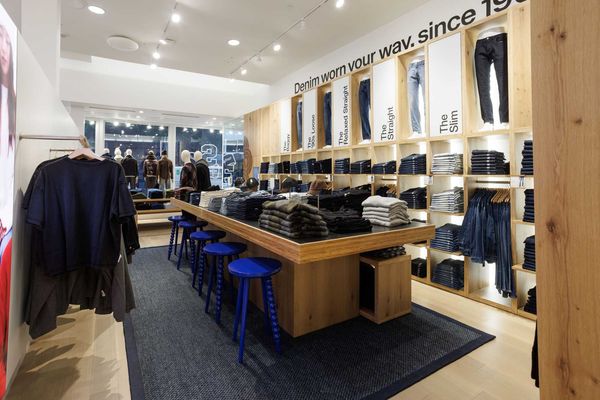With Gavin Newsom’s purposed Sit/Lie ordinance ready to remove the street kids from the Upper Haight, our relationship with the city’s most iconic neighborhood is more complicated than ever.
Question: How many hippies does it take to change a light bulb?
Answer: None. Hippies change nothing.
This is a joke that Melissa trades with her friends Nate and Casy, three twenty-somethings who call Haight Street home. Whether or not you’ve seen Melissa herself, she’s a familiar sight in the neighborhood. Camped out in front of Kan Zaman, at the intersection of Shrader Street, she sports a partially shaved head, wears a Germs T-shirt and identifies with the “gutter punk” scene. What money she and her friends get from panhandling, they use for food or concert tickets.
Of course, street kids are nothing new to the Haight, but the wave of panhandlers that have hit its streets since the late ’90s has little in common with its hippie forebears—or at least that’s the common perception. Julianna, a cashier at an upscale thrift store in the neighborhood, compares the kids to posers: “They’re trying to relive that lifestyle, but it’s different. They’re just rude.” This group of gutter punks is the first to admit that they’re partly there to take advantage of the easy money. Cody, a Tennessee native wearing an Operation Ivy shirt and holding a cardboard sign outside Escape from New York Pizza, says he’s here because of the foot traffic and the fact that “people will lend you a cigarette.” The tourists who come to see the Haight for its history as the birthplace of free love are one of the main attractions for street kids looking for handouts.
That, and—as one kid admits—the plethora of drugs.
On a more philosophical point, “Where else you going to go?” Melissa asks. For these kids, the Haight offers community. Compared with SF’s other neighborhoods, the divergent groups of hippies and punks have felt relatively welcomed in the Haight. “It doesn’t matter who you are as long as you’re cool,” explains the mohawked Nate.
This sense of community has made the Haight home to many a social refugee—perhaps too many, claim some residents. The Haight Ashbury Improvement Association, among other community groups, has lobbied for the controversial Sit/Lie ordinance that would effectively outlaw sitting or lying on public sidewalks for most of the day. In March, with the backing of the city’s police department, Mayor Gavin Newsom proposed the law; in May he declared he’ll bypass the Board of Supervisors and take the issue directly to the voters this November. The law has widely been acknowledged as a direct response to aggressive behavior by the street kids in the Haight. Tony Winnicker, Newsom’s communication director, defended the proposed law to The New York Times: “It’s about unacceptable behavior and giving police another tool to deal with it.” Meanwhile, homeless-advocacy organizations and groups such as the US PROStitutes Collective believe that the law is endangering freedoms and has the potential to cause “noncriminals to … conduct criminal behavior,” explains Neil Donovan, executive director of the National Coalition for the Homeless.
While San Franciscans have a more complex relationship with the homeless who populate neighborhoods such as the Tenderloin, the kids in the Haight are generally considered able-bodied vagrants who are there by choice rather than circumstance—or “trustafarians,” which the populist-based Urban Dictionary defines as “a person who, in an act of rebellion, has taken to smoking pot, pan-handling, and following Grateful Dead rip-off bands during the week, and then returning to his or her parent’s cozy home in the suburbs during the weekend.” But while the moniker has often been associated with the dreadlocked, cardboard sign–wielding kids on the street, the truth is that most of them are runaways, homeless, or dealing with drug addiction. Most of the kids I spoke to for this story sleep wherever they can, including in nearby Golden Gate Park; at least one had been on the road for years. They’ve sniffed many things, but never a trust fund.
The hippies of yesteryear may have come to the Haight for similar reasons as today’s kids—youthful restlessness, aimlessness, running from a troubled home life. But they were also in the right place at the right time, becoming symbols of very real cultural shifts, such as the civil-rights and anti-war movements. This gave them a sense of identity and even purpose. By contrast, the neo-hippies who now line the sidewalks of Haight Street—literally and metaphorically poised between the chain stores and the head shops—are stranded in a time and place where they no longer hold any significance.
When people worldwide think of San Francisco, they think of 1967’s Summer of Love. But the Haight hasn’t always had this identification. In the 1940s, the Upper Haight was composed of middle-class families. That shifted some 10 years later, when a proposed highway through the Panhandle caused property values to plummet. The availability of cheap housing in the 1960s enticed free spirits to the Haight and it became a breeding ground for free love and folk music.
If you talk to the Red Victorian’s owner, Dr. Sami Sunchild, that spirit deserves to be honored. Located on the corner of Haight and Belevedere, the Red Victorian is a hotel, cafe and what Sunchild calls a “living museum where 1967 and flower power can be remembered.” Sunchild painted the building its iconic shade of red when she moved here in 1978.
It’s clear to Sunchild, now in her 80s, that the kids she sees on the street aren’t the same as the hippies who came here in the ’60s looking for peace and love. Mental-health issues and “lots of negativity” have been a challenge for the community. “They buried the hippie in Golden Gate Park,” she laughs, but “people are still looking for the dream and we provide it.”
But many San Franciscans feel that hanging onto to a decades-gone image of the Haight has choked progress in the area—and in doing so, the neighborhood has lost touch with the present. The flower children of the ’60s are today’s residents and homeowners, and the area that was once on the cutting edge of counterculture now seems outdated and artificial.
Mary Rodriguez, an SF native currently living in Portola, looks like just the type of twenty-something who should be attracted to an “alternative” neighborhood like the Haight: She gets around on a road bike, sports librarian glasses, and works as a barista while earning a graduate degree. But, she says, the Haight holds little appeal for people like her. “Our generation is more interested in mixed-use buildings, accessibility, community mixing with the commercial, organic foods, local produce. The Haight just doesn’t feel organically grown: head shops, tie-dye and American Apparel.”
She has a point. Though a few popular bars and restaurants—such as Magnolia Pub, the Alembic and the Citrus Club—have operated in the Haight with success, a large part of the neighborhood’s retail businesses are still made up of head shops, thrift stores and tourist boutiques. While Valencia Street is hopping on a Saturday, the Upper Haight’s nightlife is pretty much relegated to people smoking cigarettes outside the Red Vic Movie House or waiting for the 71 Haight-Noriega bus headed downtown.
Compared to the Mission District—which, in 2009, voted to prohibit American Apparel from setting up shop—the Haight also has its share of chains, including McDonalds, Happy Donuts and Ben & Jerry’s. Whole Foods is opening on the corner of Haight and Stanyan this fall and the Gap had a shop near the iconic Haight-Ashbury intersection for several years. When Haight Street became “gentrified” in the 1990s, attempts to woo a more well-heeled crowd led to this string of chains that are now the very thing that turns away young urbanites looking for a counter-cultural, independent experience.
Chad, a late twenty-something merchant at the thrift store Held Over, has lived in the Haight for 10 years and speaks of the social scene like a seasoned veteran. He has another theory as to why fewer of his peers live in the area. In addition to the businesses not appealing to young professionals, the rent in the area has steadily risen in recent years. “Rent is going up. A lot of money is going to the Mission and people are moving there while they can still afford it.” The average house in the Haight currently costs about $840,000, as opposed to $680,000 in the Mission. And the average two-bedroom rents for $2,659 vs. $2,383 in the Mission.
Add it all up—the tourist shops, the chain stores, the wealth of adjacent neighborhoods such as Cole Valley and Ashbury Heights, and the paucity of the kids on the street—and the Haight has acquired a split personality. The counter-cultural center of the city has shifted to the more bohemian Mission, the music venues are now scattered largely in SoMa and great shopping can be had on Hayes Street. People are drawn to communities with a strong identity, while the Upper Haight is clearly struggling to define—or redefine—itself.
What was once a hotbed of radicalism has become a stop on a bus tour of San Francisco. If the new Sit/Lie ordinance passes, the gutter punks will be gone, perhaps forced home to disapproving parents or to rehab, or pushed into mainstream endeavors like college and full-time jobs. And when that happens, the last living vestiges of the neighborhood’s former identity will disappear.
Many residents will undoubtedly celebrate. But in time, some of them may regret the Haight’s increasingly mainstreamed facelift, dipping into Cherry Garcia from the Stanyan Street Whole Foods in a weak attempt to get a taste of that free spirit again.
Photo by: Aubrie Pick




















